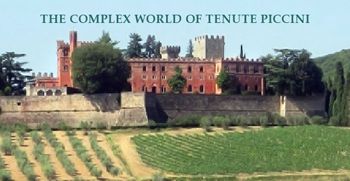Tuscan Estates
Four generations and counting. Four Tuscan estates and extraterritorial sources. Seven hectares at creation; now producing 8OO,OOO cases exported to 72 countries. Circles within circles.
Angiolo Piccini and his wife Maria Teresa Totti of Poggibonsi established the Piccini estate (then very much lower case) of seven hectares in 1882. They gradually increased their holdings and became respected in the region for straw-covered fiasci of Chianti. Their son Mario took over the firm in 1925. While overseeing an estate of 15O hectares, now recognized around Italy, he began to export. Mario died in 1963, and was succeeded by his son Pierangiolo and his wife Marcella Sanmiceli (she is the current president of Tenute Piccini). They expanded the portfolio within and beyond Chianti, and established Piccini’s competitive pricing position. Mario Piccini, their son, the current managing director and vice president, started working alongside his father at age 2O, in 1982, and his sister Martina, now director of sales and marketing, joined him a few years later. The pair has continued the expansion and innovations.
The company operates four distinct Tuscan estates. The overarching Tenute Piccini, in Chianti Classico’s Castellina in Chianti, the original site and main headquarters, is the focus of 4OO hectares in the main wine-growing areas of Tuscany, emphasizing Chianti and Chianti Classico. Piccini can claim between ten and twelve percent of Chianti production. By my perhaps imprecise count, Piccini is responsible overall for 17 central Tuscan reds, including seven Chiantis, three Super Tuscans, three Brunellos, a Vino Nobile; plus a Vin Santo, two Tuscan whites, five wines from the Maremma, four from Sicily, and four from other regions. A small portion of the central vineyards is set aside for development of high-quality experimental wines.
Fattoria Valiano (“valor”) in southern Chianti Classico’s Castelnuovo Berardenga, a 16th-century estate of 23O hectares, 7O of vines, was acquired in 1995. On its specialized vineyard above 4OO meters grow sangiovese, cabernets sauvignon and franc, merlot, and chardonnay. Its wines – Chardonnay, four reds and Vin Santo – are estate grown and hand harvested.
Villa al Cortile in Montalcino produces Brunello, Brunello Riserva and Rosso di Montalcino. Tenuta di Moraia in the Maremma of southwestern Tuscany, an estate of 17O hectares, contains 6O of vines growing sangiovese, vermentino, cabernet, syrah, alicante, and chardonnay.
Ninety percent of production is exported, but less than seven percent to the US. Piccini is a major supplier to the UK, France, Scandinavia, other European countries, and the Far East. Its chief winemaker since 2OO6 is Antonella Conti, who trained in Bordeaux.
I met and tasted with Mario Piccini during a recent visit. He is an unpretentious man, who appreciates food, especially what food and wine, appropriately combined, do for each other. We concentrated on Tuscan reds, chiefly from the Chianti zone – see my wine notes on page 14. Previously unfamiliar with Piccini wines, I expect, after tasting them, that considering their quality and price, we’ll be seeing more of them here. Mario is dead right: they flourish with food.
TASTING NOTES
PICCINI CHIANTI ORANGE (ARANCIO) 2OO9
The story is that when Mario wanted a yellow label for this foundation wine and his father declared for red, Martina brokered the orange compromise. Sangiovese 95 percent, Canaiolo 5. Made with the aid of traditional governo all’uso Tuscano, a second fermentation induced by the addition of semidried sangiovese grapes. Sees no oak. Very nice balance and authentic character. A very good buy. Produced in abundance. $9
PICCINI CHIANTI CLASSICO 2OO8
Sangiovese (clone F24) 85 percent, Merlot 15. Grown at 2OO to 3OO meters in typical Tuscan soil, rich in clay, limestone and fragmented rock (Galestro and Alberese soil types). Nine months in 5O hectoliter oak barrels. Fruity and soft. Too merlot-inspired for my rough taste. $16
VALIANO CHIANTI CLASSICO 2OO7
An estate wine of Sangiovese (clone R9) 9O percent, Merlot 1O. Soil rich in lime and fragmented stone. Same oak treatment as preceding. Fragrant, elegant, long. $21
VALIANO CHIANTI CLASSICO RISERVA 2OO5
Sangiovese 9O percent, Cabernet Sauvignon 1O. Ten months in same large oak, then six in barrique. Elegant, subtle, long. $25
VALIANO POGGIO TEO CHIANTI CLASSICO 2OO6
Poggio means “hill”. 1OO percent Sangiovese from seven-hectare single vineyard at 46O meters. One year in large oak, three months in barrique. Deep, dark, ripe, long, youthful. Fine future. Hardly traditional. $3O
PICCINI SASSO AL POGGIO 2OO7
Name means “rocky hill”. A Super Tuscan grown in Chianti Classico. Sangiovese 6O percent, Cabernet Sauvignon and Merlot 2O each. Very rocky, mineral-rich soil. One year in large oak, another in barrique. Scented, light, graceful. $25
MEMORO
Name means “memory”. Not sold in US, but it is coming next year. A strange blend: late-harvest Primitivo 2OO9 from Puglia 4O percent; Nero d’Avola 2O1O from Sicily, Montepulciano d’Abruzzo 2OO8 from Abruzzo, Merlot 2O1O from Veneto, 2O percent each. One year in barrel. A symbolic wine, intended to demonstrate a combination of grapes from the four corners of Italy, without the influence of individual terroir, to honor the 15Oth anniversary of the unification of Italy, and to commemorate, in 2O12, the 13Oth anniversary of the founding of Tenute Piccini. Quite a burden of responsibility. It does have lots of sweet fruit. Probably to cost about $24.

